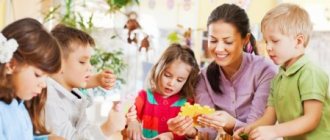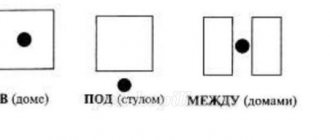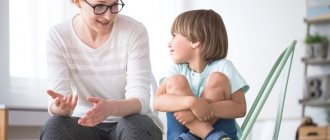Compiling the story “Autumn” using a mnemonic table (middle group – from 4 to 5 years old)
Sveta Sirotkina
Compiling the story “Autumn” using a mnemonic table (middle group – from 4 to 5 years old)
Topic: “ Composing the story “ Autumn ”
according to
the mnemonic table "
( middle group – from 4 to 5 years )
Goal: to consolidate children’s ideas about the characteristic signs of autumn and autumn phenomena .
1. Exercise children in the ability to talk about the seasons ( autumn )
using visual aids (
mnemonic squares , mnemonic table , coherently, in a logical sequence.
2. Develop vocabulary - name the distinctive features of autumn , wild animals, birds using a mnemonic table .
3. Strengthen the skill of forming an adjective from a noun.
4. Continue to develop mental processes: memory, attention, visual and effective thinking.
5. Develop the ability to correlate drawn symbols with an image.
6. Cultivate a kind attitude towards nature, show care for it.
Material: Demonstration: mnemonic squares , mnemonic table “ Autumn ”
,basket, pointer, ball, phonogram with music
“Dance with
Autumn Leaves ” , music by P. I. Tchaikovsky
“October”
.
Handout: 2 autumn
Previous work: observing autumn changes in nature, looking at illustrations , conversations, memorizing poems about autumn , getting acquainted with symbols - drawings of mnemonic squares , learning visual and finger gymnastics, singing songs about autumn .
Integration of educational areas: “Communication”
,
“Cognition”
,
“Health”
,
“Music”
,
“Reading art.
literature" .
Change of positions: org. moment - standing in a circle on the carpet;
Part 1 - sitting at desks
musical-dynamic pause - in a circle on the carpet;
Part 2 - at the desks
the result is on the mat in a free position.
Mnemonic tracks and mnemonic tables on the topics “Autumn”, “Winter”, “Spring”.
Transcript
1 Mnemonic tracks and mnemonic tables on the topics “Autumn”, “Winter”, “Spring”.
2 “Autumn” In autumn, people go to the forest to pick mushrooms (large and small).
3 In autumn, the sun shines little, it often rains, the wind blows, and leaves fall.
4 In autumn, the leaves on the trees become multi-colored, and only the Christmas tree remains always green.
5 In autumn, the sun shines little, clouds appear in the sky, from which it rains; The wind is blowing, leaves are flying.
6 In autumn, all the trees put on a colorful outfit. But the wind blew and tore a leaf from the branch. He flew. The sun shines little, it rains often, mushrooms appear in the forest after the rain, and during the rain we hide under an umbrella.
7 In autumn it often rains, you can pick mushrooms in the forest. In autumn it often rains and mushrooms grow in the forest.
8 In autumn, the sun shines little, it rains often, and the wind blows, which tears leaves from the tree. We hide from the rain under an umbrella.
9 In autumn it often rains, a cold wind blows, you and I hide from the rain under an umbrella.
10 In autumn the sun shines little, it rains often, you can pick mushrooms in the forest and put them in a basket. The wind blows, plucks leaves, and apples and fruits ripen in the garden.
11 In autumn, the sky is covered with clouds, and it often rains. In autumn, mushrooms grow in the forest, and apples ripen in the orchards.
12 In autumn, leaves fall from the trees, and this phenomenon is called leaf fall.
13 In autumn, clouds often appear in the sky from which it rains. The wind is blowing, leaves are flying from the trees. Birds fly away to warmer climes.
14 In autumn, the sun is often obscured by clouds, from which it often rains. You and I are hiding from the rain under an umbrella. The wind blows and tears leaves from the trees. Birds fly away to warmer regions.
15 “Winter” In winter there is a lot of snow outside, you can make snowmen out of it.
16 In winter, the sun shines little, it’s cold, frost draws patterns on the windows, children put on mittens.
17 In winter it often snows, children make snowmen from it and go skiing.
18 In winter it often snows, children love to play snowballs, build a snowman, and go sledding.
19 In winter there is a lot of snow outside, it falls in the form of snowflakes. Children love to make snowballs out of it and play with each other, sledding, downhill, and making a snowman. The sun shines rarely and little.
20 It's cold and frosty in winter. Frost on the windows draws different patterns. In winter it often snows, it is cold and frosty. The sun shines little and rarely.
21 It often snows in winter. Children love to make snowmen out of snow.
22 In winter, the sun shines rarely and little. It often snows, is cold and frosty. The sky is often overcast with clouds from which snow falls.
23 In winter the sun rarely shines. It’s frosty, the frost on the windows draws different patterns. It's snowing, a cold wind is blowing. Children make snowballs from snow and make a snowman.
24 In winter it is cold, frosty, it often snows, snowflakes fall from the sky. In winter, the sun shines little, it is cold and frosty, and it often snows.
25 In winter, the sun shines little and it often snows, in the form of large snowflakes. Children love to ride on the slide in winter.
26 In winter, the sun shines little, it is cold and frosty, it often snows, and children make snowmen and go sledding.
27 In winter it is cold and frosty, it often snows, there is a lot of it. The sun shines rarely and little. Children love to play snowballs, make snowmen, ride a slide, and really love skiing.
28 “Spring” In spring there is more sunshine. It warms up, the icicles begin to melt, everyone celebrates mother’s holiday.
29 In the spring the sun warms up, the icicles melt, puddles appear, you can launch boats into them.
30 In the spring the sun warms up, the icicles melt, puddles appear, everyone celebrates their mother’s holiday on March 8th in the spring.
31 In the spring the sun warms up, the icicles melt on the roofs. Puddles appear and you can launch boats into them. We celebrate mother's holiday on March 8th, the willow tree is bushy.
32 In spring the sun warms up and the icicles melt. Puddles appear, children launch boats into them and in the streams. The willow is fluffing up, everyone is celebrating mother's holiday on March 8th. Birds begin to fly in from distant countries.
33 In spring, the warm and gentle sun warms us, buds with leaves appear on the branches. In spring, the warm sun warms, the buds swell, leaves and young grass appear.
34 In spring there is a lot of light. The day is coming. The sun becomes warm and gentle. Green leaves appear.
35 In spring the warm and gentle sun warms us. Leaves appear from the buds. Grass with flowers grows, and birds fly in.
36 In spring, the days become longer. Light. The warm and gentle sun warms you. The buds swell and leaves appear. The grass is turning green, the flowers are blooming. Birds fly from distant countries, trees in the forest are covered with leaves.
37 In spring, the grass is green, the trees have green leaves. In spring, the sun shines and warms, green grass and dandelion flowers appear.
38 In spring, green grass appears. Dandelion flowers grow in the grass, and butterflies fly to them.
39 In spring, the sun is warm and green grass wakes up under its rays. There are green leaves on the trees, flowers are blooming, insects are flying in.
40 In spring the sun shines and warms. Warm. There are green leaves on the trees. Flowers are blooming in the grass. Insects arrive. Birds appear in the forest. It's good in spring!
Development of fantasy
In preschool educational institutions (DOU), mnemonic tables can be used to develop thinking and imagination. You should start with simple signs that depict objects denoted by one word or phrase. There are 4 signs in total. Then the task becomes more complicated. The teacher should arrange the cards in the form of a square. Following the path of the square, children must compose a short story of two or three sentences. At first, you can ask children leading questions. Then we can offer mnemonic tables with the help of which a whole story is compiled. Also, using these tables you can simplify the task of memorizing a story or poem.
At first, the teacher compiles mnemonic tables. When children have sufficiently grasped the essence of mnemonics, they can begin to be introduced to the process of creating tables.
Middle group
Increasingly, in preschool educational institutions, this technique is used not only by teachers and speech therapists, but also by other specialists: music director, physical worker, art teacher. The use of mnemonics for preschoolers is very important in the work of a defectologist.
In the middle group, mnemonics can be used to develop attention, imagination, and creative abilities. Also, using mnemonic tables, children can be taught to memorize poetry. With the help of mnemonics, children develop taste, tactile, visual, motor and auditory memory.
Every year there are more and more children with limited vocabulary. Children's speech consists of simple sentences using non-literary words. It often happens that a child cannot correctly formulate his question or answer. Many children are not able to retell even a short text. The use of mnemonics for preschoolers helps educators solve these problems.
For mnemonics in the middle group, they use not only pictures, but also geometric figures, symbols, plans, and silhouette images. With the help of mnemonics, you can teach your child not only to guess, but also to make riddles, which will also have a positive effect on speech development.
What does mnemonics give?
As a result of using schema tables and mnemonic tables:
- Not only vocabulary expands, but also knowledge about the world around us.
- There is a desire to retell it - the child understands that it is not at all difficult.
- Memorizing poetry turns into a game that children really like.
- This is one of the effective ways to develop speech in preschoolers.
It must be remembered that the level of speech development is determined by the child’s vocabulary. And just a few steps taken in this direction will help you develop your preschooler’s speech.
Junior group
In the younger group, you can use mnemonics to easily remember the sequence of different processes (the method of auditoryization, not visualization, already works here). For example: hand washing sequence. Open the tap → take soap → soap your hands → rinse your hands → close the tap → dry your hands with a towel.
The same method can be used to teach the sequence of dressing, brushing teeth, etc.
Using mnemonic diagrams, it is good to tell children about animals, insects, and birds. Using mnemonic tables you can create a riddle. You need to cover several cards so that the children can guess what is shown on them. For example: The picture shows a hare. The teacher closes the next picture and asks where the hare lives (in the forest). What does a hare eat? (grass, stems, tree bark). What color is a hare's coat? (gray, white). After the children have answered the question, the picture needs to be opened. If the children find it difficult to answer, the teacher gives hints or answers himself.
Progress of the lesson.
Greetings. Children enter to the music.
Q: Guys, how does this music make you feel? What kind of music is this?
D.: calm, sad, sad.
Q: What time of year is it now?
D.: autumn .
V.: Today we will talk about autumn . Guys, what words can you use to start a story about autumn ?
D.: autumn , autumn .
V.: I suggest you tell us what you know about autumn using a table .
Children's storytelling using the mnemonic table " Autumn "
.
V.: oh, guys, I hear something, it seems like someone is crying?
A toy bunny with a carrot appears.
Bunny: Hello, guys!
D.: Hello, bunny! We are very glad to see you visiting us.
V.: Let's pet the bunny. We are not afraid of him, and he is not afraid of us either.
Why are you crying, bunny?
Bunny: I’m crying because a wolf was chasing me. I was picking vegetables in my garden, and the wolf probably wanted to take my carrots away. What should I take to my bunnies?
V.: Don't cry, bunny. Let's guys sit on the chairs and calm the bunny down. What should we call him affectionately?
D.: bunny, bunny, bunny….
Bunny: thank you guys, you are so kind.
V.: Guys, let’s tell you what we know about the bunny.
Children's storytelling using the mnemonic table “Hare”
Bunny: Well done! I really love grass, cabbage, carrots, and the wolf wanted to take away my carrots and all the vegetables.
V.: Don't cry, bunny. Now the guys will tell you everything about the wolf .
Children's storytelling using the mnemonic table “Wolf”
Bunny: thanks guys, that means he didn’t need the carrot, he wanted to eat me. Now I also know everything about the wolf and can outsmart him. Let's play our bunny game "Wolf and Hares"
They turned into bunnies.
The bunny puts on a wolf mask, and the guys turn into bunnies.
Bunny: Spin around, spin around -
And they turned into kids.
The children take their seats.
Bunny: it’s cold outside, I don’t like autumn . Do you guys like autumn ?
D.: It can be cold in the fall , it rains, there are puddles in the yard.
V.: but our guys won’t go into puddles.
V.: Bunny, how do you understand the expression “A smart person won’t go into a puddle, a smart person will avoid a puddle”
?
Bunny: I'm smart, I run through puddles - it's so cool! Try it guys!
V.: What are you, bunny, you can’t run through puddles.
Bunny: why? Here I am running. Tell me why you can’t run through puddles?
D.: You can get your feet wet and get sick.
V.: That’s why you can’t go running through puddles.
Bunny: yes, now I will also avoid puddles. Who likes autumn and why ? Children's answers.
Bunny: now I know that in autumn there is something good and something bad.
V.: Now, guys, let’s put our hands on our knees and try to remember what we did today.
D.: listened carefully to the music, came up with affectionate words for the bunny. Based on the pictures, we made up stories about a hare , a wolf, and came up with a story about autumn . Together we played the game “Wolf and Hares”
.
V.: You had a wonderful rest, and now the lesson is over. Bunny has a treat for you!
Musical lounge “Autumn Sadness” Musical lounge “Autumn Sadness” Purpose: Through classical music, help to see the beauty of nature. Objectives: 1. Improve musical skills.
Song Autumn is a sad time! for older children. Autumn is the time of year when significant changes occur in nature. She is bright, unpredictable, generous. It causes something different for each of us.
Source




